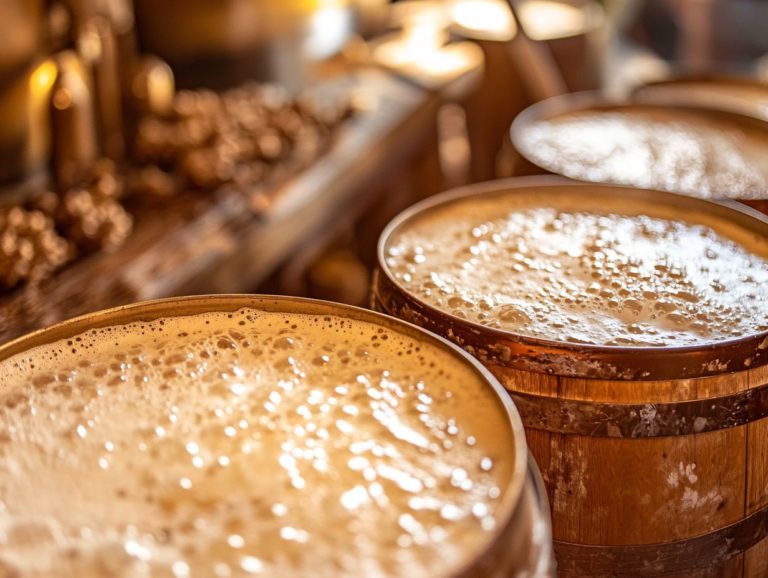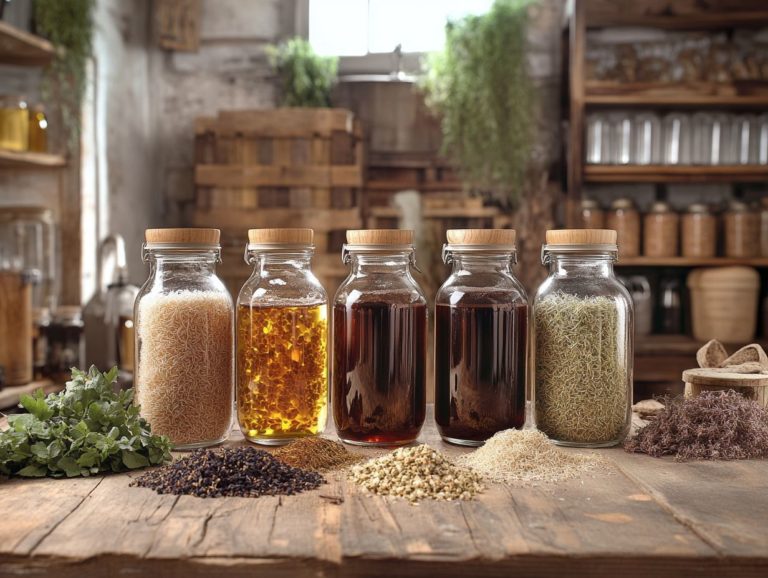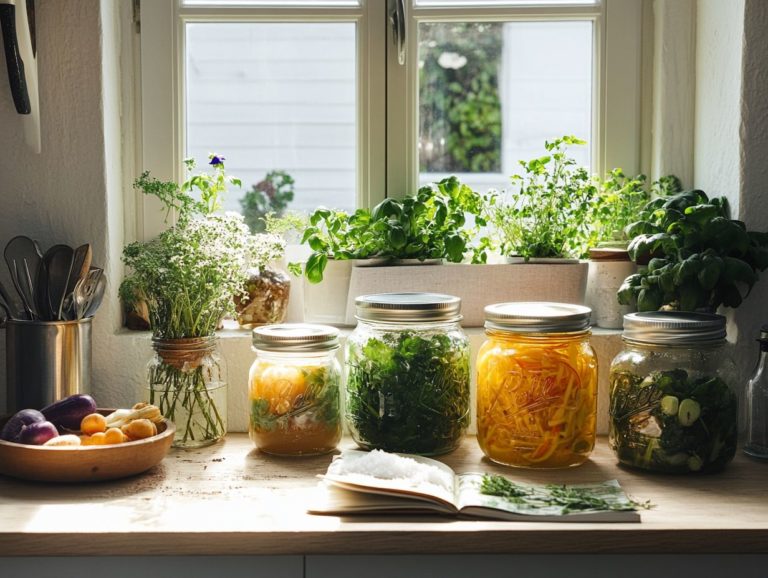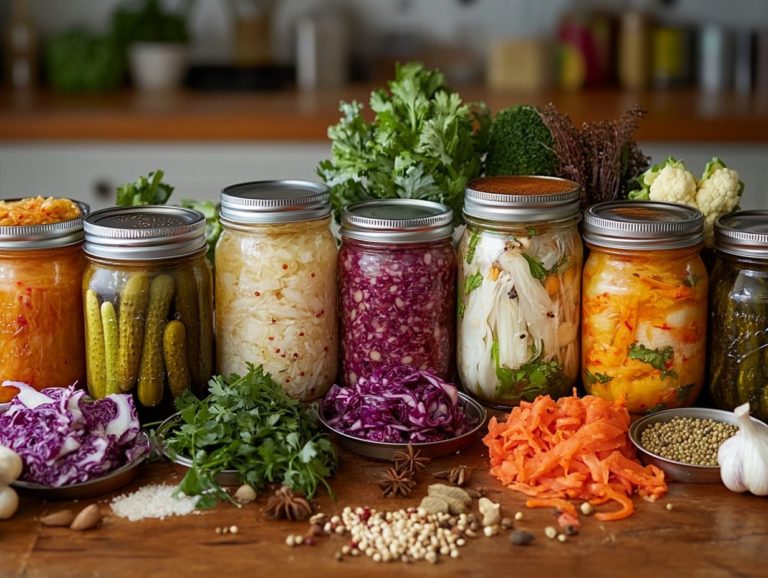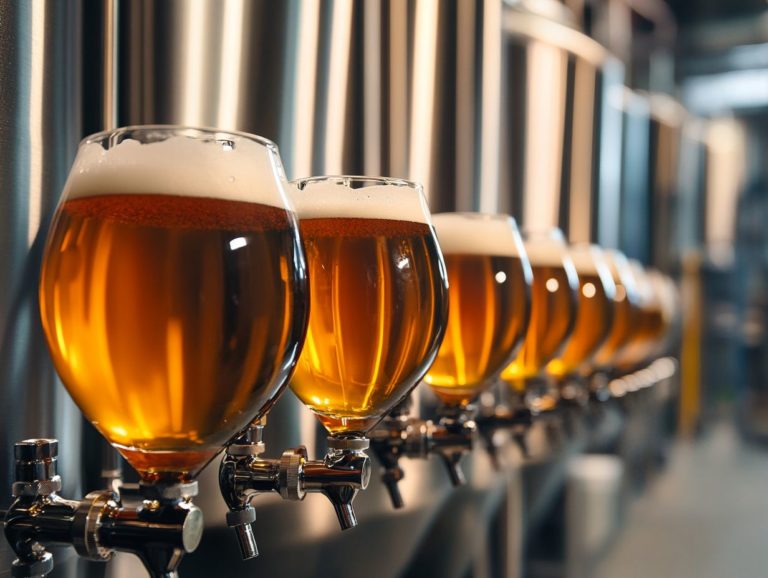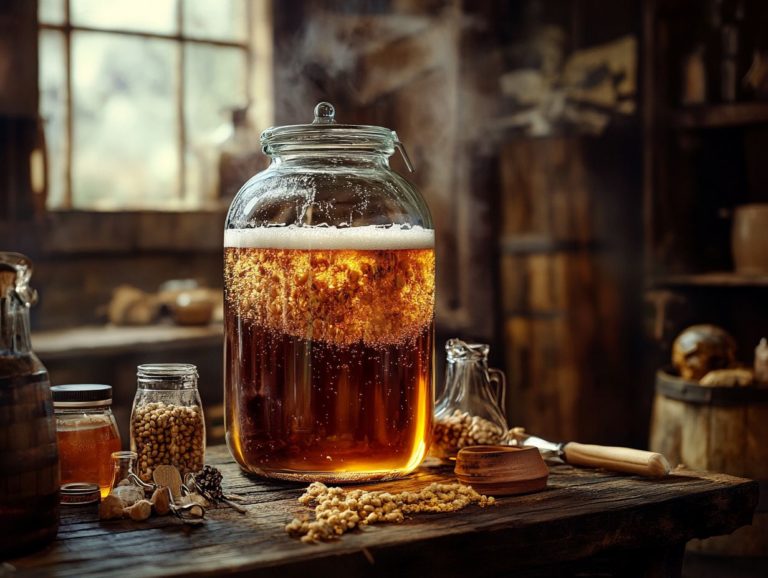Understanding Fermentation Off-Flavors
Fermented foods are renowned for their distinctive flavors and impressive health benefits, but every so often, you might encounter some off-flavors, such as solvent character or hydrogen sulfide, that may spoil the experience.
These unwelcome tastes can arise from a variety of factors, including contamination, toxins, improper fermentation techniques, or even the production of butyric acid and diacetyl.
In this exploration, you ll uncover the common causes of off-flavors in fermented foods, identify the most frequently encountered undesirable tastes, and gain practical tips to detect and prevent these issues.
Whether you re a seasoned fermenter or just dipping your toes into the world of fermentation, grasping these aspects will empower you to create delightful, high-quality fermented products.
Contents
Key Takeaways:
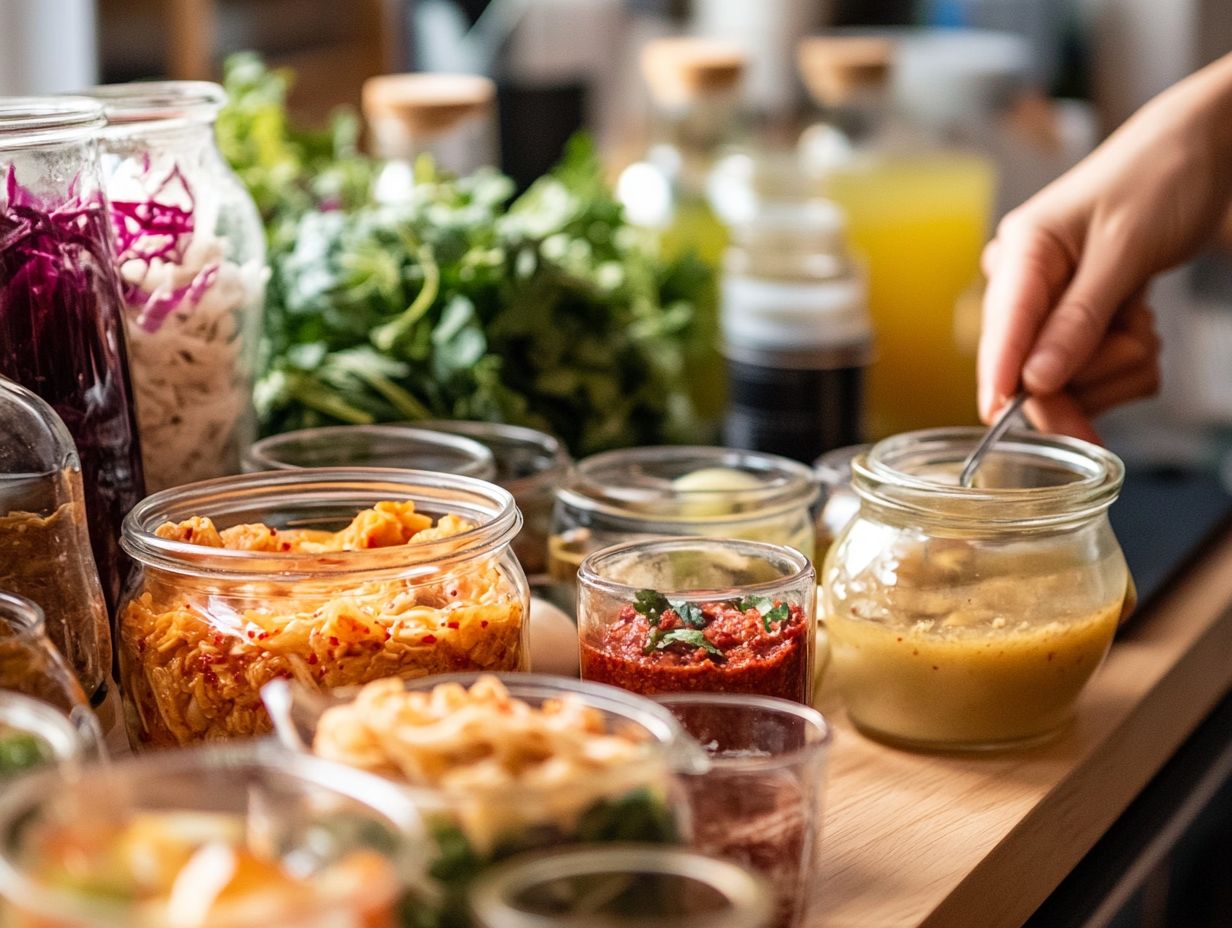
- Contamination and improper fermentation conditions are common causes of off-flavors in fermented foods.
- The most common off-flavors in fermented foods include rancid, yeasty, sour, putrid, metallic, moldy, and solvent character flavors.
- To prevent off-flavors, regularly clean equipment, control fermentation temperature and time, use quality ingredients, properly store, and practice good hygiene and sanitation.
What Causes Off-Flavors in Fermented Foods?
Off-flavors in fermented foods can greatly diminish the quality and enjoyment of your products. These unwanted tastes can stem from numerous factors, such as inadequate brewing practices, yeast metabolism issues, and spoilage organisms causing contamination, or even the presence of high levels of diacetyl and mercaptan.
These flavors disrupt the intended flavor profile and complicate flavor perception, especially in beverages like high-gravity beer and Belgian dark strong ales, which are particularly sensitive to temperature control and the production of acetate esters during fermentation.
Understanding the causes of off-flavors empowers you to handle beer better and improve brewing practices, such as those practiced by the Odell Brewing Company, that reduce the presence of undesirable flavor compounds.
1. Contamination by Spoilage Organisms
Contamination by spoilage organisms is a leading culprit behind off-flavors in fermented foods, as these microorganisms can introduce unwanted flavors that dramatically alter the product’s profile.
These diverse spoilage organisms, including wild yeast and bacteria, often find their way into the fermentation process, resulting in an array of undesirable characteristics. For example, brewers may unwittingly invite lactic acid bacteria into the mix, which can impart an unwelcome sourness in certain beer styles. Utilizing yeast strains such as Wyeast 1762 Belgian Abbey II can help maintain the intended profile.
You might have heard stories from brewing practices where one rogue batch turned overly acidic due to contamination, necessitating a complete flavor overhaul. This highlights that proper sanitation is truly the linchpin in averting these disruptions. Maintaining a pristine workspace and utilizing techniques like pasteurization can significantly reduce risks.
Implementing strategies such as regular equipment cleaning and adjusting yeast pitching rates can establish a more controlled environment, minimizing the chance of spoilage and ensuring you achieve the desired taste profile.
2. Presence of Toxins or Chemicals
The presence of toxins or chemicals in your fermented foods can lead to those undesirable off-flavors that compromise both the quality and safety of your beverage.
These off-flavors can stem from various sources, including the raw ingredients you choose, the fermentation environment, and even the equipment you use during production. For instance, moldy grains or contaminated yeast can introduce musty or sour notes that are far from appealing. If the fermentation vessels aren t cleaned properly, residual sanitizers or cleaning agents might taint your brew, resulting in pesky chemical off-flavors.
To ensure the purity of your ingredients, it’s crucial to source high-quality materials and adhere to strict hygiene protocols. Regularly monitoring pH levels and conducting taste tests throughout the brewing process can also help you maintain that exceptional quality.
Ultimately, paying close attention to these details not only preserves the flavor but also guarantees a safe drinking experience for you and your consumers.
Brewers, take charge of your quality! Start implementing these tips today to elevate your brewing game!
What Are the Most Common Off-Flavors in Fermented Foods?
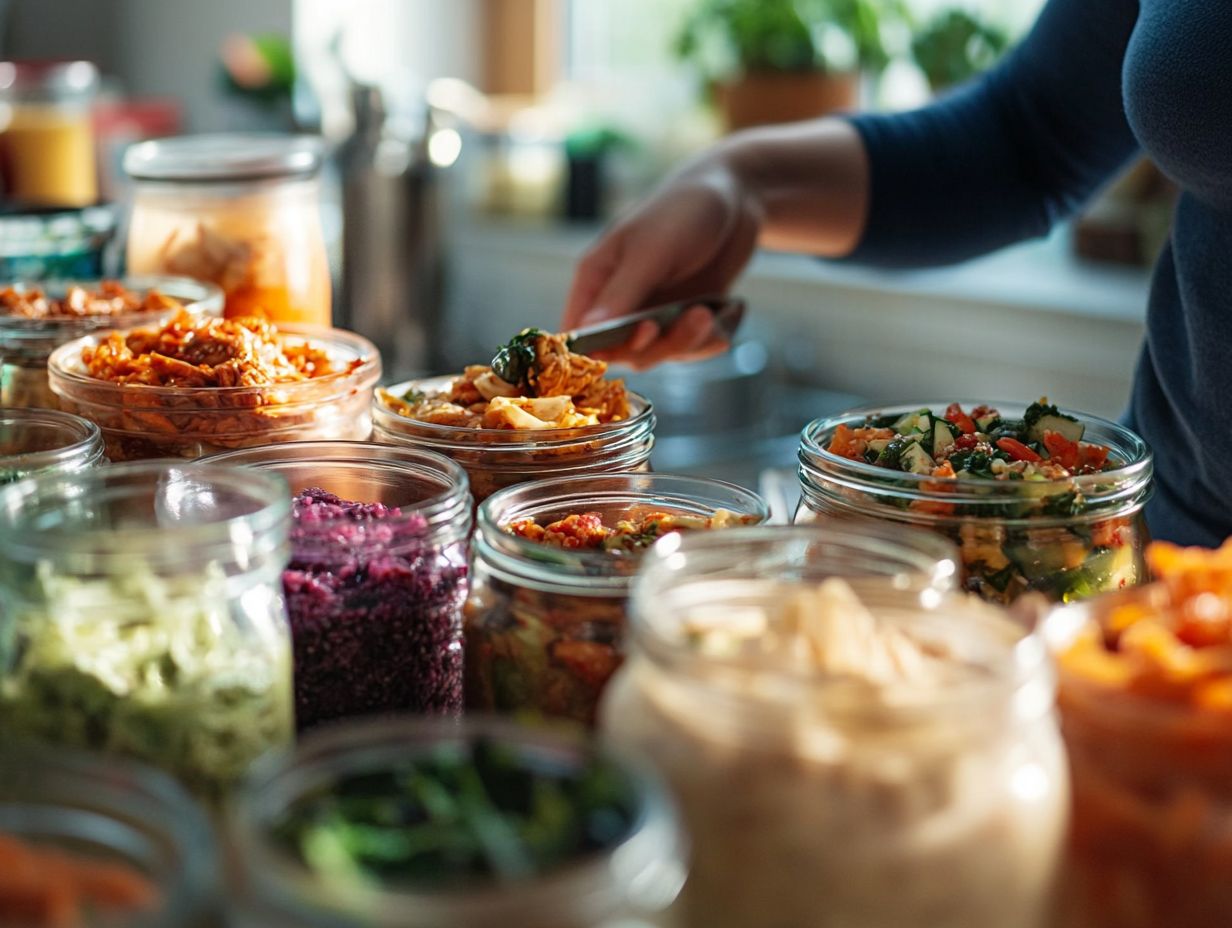
You may encounter various common off-flavors in fermented foods, each presenting distinct challenges that can affect your overall enjoyment of the products. Rancid flavors often serve as a warning sign of oxidation, while yeasty notes might arise from over-attenuation or prolonged fermentation times.
Sour flavors can indicate bacterial contamination, but remember that some sour beers are crafted to embrace such characteristics. Putrid, metallic, and moldy flavors often indicate poor ingredient quality or contamination.
Recognizing and addressing these issues is crucial for you as a brewer. It allows you to enhance the flavor quality and elevate your creations.
1. Rancid/Oxidized Flavor
Rancid or oxidized flavors can seriously impact the quality of your fermented foods, often stemming from improper handling and unwanted exposure to oxygen.
These off-flavors arise from the breakdown of fats and oils, resulting in an unpleasant sour taste that overshadows the intricate nuances you intended to highlight in your beverage. In the realm of fermented foods, such as sour beers or cheeses, oxidation can present as stale or cardboard-like characteristics, significantly detracting from the overall sensory experience.
You must employ proper handling techniques that minimize oxygen exposure during both transfer and storage. Utilizing airtight packaging solutions, such as cans or dark bottles, effectively shields your product from light and air, preserving its intended flavor profile and ensuring a more pleasurable tasting experience for you and your audience.
3. Improper Fermentation Conditions
Improper fermentation conditions can disrupt yeast metabolism, leading to off-flavors that negatively impact flavor perception and the integrity of your final product.
This issue becomes pronounced in high-gravity beers and various fermented foods, where maintaining delicate balances is essential for achieving a desirable profile. Temperature control is critical; for instance, Belgian dark strong ales flourish when fermented at temperatures between 68 F and 75 F. If the temperatures are too low, fermentation may stall. Conversely, excessively high temperatures can result in unwanted esters or fusel alcohols that muddle the flavor.
Fermentation time is also vital. Allowing fermentation to extend too long can lead to the overproduction of byproducts like diacetyl, a byproduct of fermentation that gives a buttery flavor, detracting from the complex notes you intend for your brew. Therefore, diligently monitoring these parameters is essential to ensure that your product’s overall quality remains uncompromised.
4. Use of Contaminated Equipment
Using contaminated brewing equipment can introduce unwanted microbes and off-flavors, such as isoamyl acetate or DMS, into your fermented foods, compromising the quality and consistency of your creations.
This risk can greatly affect your brew’s quality, especially for those who dedicate time and resources to crafting exceptional brews. To ensure that every batch truly reflects the intended flavors and characteristics, keeping your equipment pristine is essential.
Regularly sanitizing your kegs, fermenters, and utensils is key to preventing common contaminants like wild yeast or bacteria, which can lead to undesirable sourness or off-flavors, such as diacetyl, creating buttery notes that overshadow the intended taste profile.
By employing proper sanitation techniques think hot water rinses, effective cleaning agents, and thorough drying processes you can safeguard your brewing journey and enhance the overall experience for both you as the brewer and your consumers.
2. Yeasty Flavor
Yeasty flavor is an off-flavor you might encounter in various fermented foods. It often arises from excessive yeast activity or improper fermentation practices, potentially resulting in compounds like caprylic acid.
This unpleasant taste can show up in products such as bread, beer, and wine. It significantly affects their overall quality. Several factors contribute to this off-flavor, with the choice of yeast strains being important in shaping the final flavor profile. The fermentation environment, including temperature, pH, and oxygen levels, also influences yeast behavior and the presence of those yeasty notes.
As a brewer, you must actively monitor yeast populations closely. Adjust your methods to create ideal fermentation conditions by controlling temperature fluctuations and ensuring proper yeast pitching rates, which is the amount of yeast added at the start of fermentation. These steps promote a cleaner fermentation process.
3. Sour/Acidic Flavor
The sour or acidic flavor in fermented foods can be a sought-after characteristic in certain styles. However, when it appears uninvited, it may signal contamination or excessive lactic acid production. It’s often recommended to control off-flavors using methods taught by institutions like the Siebel Institute and Flavoractiv sensory kits for practice tasting.
As sour beers continue to gain popularity, you need to distinguish between intentional and unintentional sourness. Intentional souring typically results from carefully controlled fermentation processes, using specific yeast or bacteria strains to cultivate a delightful tartness and complexity that enhances flavor. Breweries like Odell Brewing Company are known for their attention to these details.
On the flip side, undesired sourness can emerge from mishandling during brewing. This may involve the unexpected introduction of wild yeast or bacteria, leading to off-flavors and spoilage. You should adopt rigorous sanitation practices and vigilantly monitor fermentation conditions to control off-flavors.
By grasping these nuances, you can confidently produce exquisite sour styles while steering clear of unintended sourness. Regular practice tasting with flavor sensory kits will improve your flavor perception and help you detect off-flavors early.
4. Putrid/Spoiled Flavor
Putrid or spoiled flavor signals bacterial contamination in your fermented foods, emphasizing the urgent need for corrective measures. Such contamination often results in unwanted flavors like Diacetyl and Hydrogen Sulfide.
This undesirable taste often stems from specific spoilage organisms like Lactobacillus, which can produce lactic acid, leading to an unpleasant sourness, or Pseudomonas, known for thriving in cooler temperatures and imparting a distinctly off-putting aroma. If you find yourself grappling with such issues, stay alert for signs of spoilage, such as unexpected aromas, unusual sediment, or changes in color.
To effectively ward off these off-flavors, prioritize robust sanitation protocols. Conduct regular inspections of your brewing equipment and maintain optimal fermentation temperatures. Taking these steps can significantly reduce the risk of bacterial contamination from troublesome microorganisms. The Siebel Institute offers excellent courses on proper sanitation and brewing practices.
5. Metallic Flavor
The metallic flavor you sometimes encounter in fermented foods often stems from the interaction between beer and specific types of brewing equipment or contaminants during the brewing process.
Inadequate sanitization can lead to metallic residues from aging or damaged equipment, which can make their unwelcome appearance. These off-flavors can significantly diminish the quality of your product, leaving you and your consumers less than satisfied. Effective temperature control can help minimize these risks.
To combat this problem, there are several preventive measures you can implement, such as:
- Practice good hygiene and proper sanitation throughout the brewing process
- Choose stainless steel equipment that is less likely to react with your ingredients
- Uphold rigorous sanitation practices
- Regularly inspect all brewing apparatus for signs of wear or damage
By adopting these strategies, you can achieve a cleaner taste profile and elevate the overall drinking experience for everyone involved. This is critical for producing exceptional high-gravity beer styles like Belgian dark strong ale, where off-flavors can be particularly noticeable.
6. Moldy Flavor

Moldy flavor in fermented foods can be an off-putting experience, often resulting from unwanted mold growth. This unpleasant taste can arise from several factors, including the quality of ingredients you choose for the fermentation process and the specific conditions in which fermentation occurs.
For example, if you use subpar raw materials that already harbor mold spores, you may encounter issues later on. Similarly, insufficient temperature and humidity control during fermentation can create a welcoming environment for mold.
To tackle these challenges, it s essential to adopt best practices, such as sourcing high-quality, mold-free ingredients and diligently monitoring fermentation conditions. For instance, using yeast strains like Wyeast 1762 (Belgian Abbey II) can help maintain the desired fermentation profile.
Maintaining a clean production environment and employing effective sealing techniques can play a pivotal role in preventing mold contamination. By taking these precautions, you can protect the integrity of your final product and ensure a delightful experience for those who enjoy your creations. This is especially relevant for flavors like Isoamyl Acetate, which can be easily masked by off-flavors.
How to Detect and Prevent Off-Flavors in Fermented Foods?
Detecting and preventing off-flavors in fermented foods is essential for preserving exceptional product quality. This involves a meticulous approach that combines regular inspections, proper sanitation, and controlled fermentation practices. Tools like flavor sensory kits from Flavoractiv can be invaluable in this process.
By embracing rigorous brewing techniques, you can proactively identify potential issues before they compromise the final product. A critical aspect of this process is grasping how fermentation temperature influences yeast metabolism and the formation of flavor compounds that contribute to flavor.
Prioritizing high-quality ingredients and upholding cleanliness throughout the brewing journey will significantly elevate your end results.
In conclusion, maintaining these practices is crucial for ensuring product quality and delivering exceptional fermented foods to your consumers.
1. Regularly Inspect and Clean Equipment
Regularly inspecting and cleaning your brewing equipment is essential for preventing off-flavors and maintaining the quality of your fermented foods. Proper sanitation can significantly reduce contamination risks.
To achieve optimal hygiene, conduct thorough checks and cleanings on a weekly basis or after each production run, depending on usage. Utilizing safe and effective sanitizing agents can significantly diminish contamination risks. Neglecting these crucial steps can lead to residual flavors that taint your final product, compromising quality and consumer satisfaction. This principle is emphasized in training programs by institutions like the Siebel Institute and Flavoractiv.
Along with regular cleaning, make it a habit to visually inspect all parts of your equipment for signs of wear and buildup. This proactive approach helps you identify areas that need immediate attention, ensuring you uphold a consistently high standard of production. Careful attention to detail sets apart beers like Pilsner Urquell from the competition.
2. Control Fermentation Temperature and Time
Controlling fermentation temperature and time is crucial for optimizing yeast metabolism. This has a direct impact on flavor quality and prevents off-flavors. This focus on precise conditions is what makes Pilsner Urquell and Heineken standout examples in the light lager category.
By maintaining the right conditions, you ensure a cleaner fermentation process and elevate the distinct characteristics of various beer styles. For example, lager yeasts thrive at lower temperatures, typically between 48 to 55 F, creating that crisp, smooth profile perfect for traditional pilsners. In contrast, ale yeasts prefer a warmer environment, around 65 to 72 F, resulting in the fruity and complex esters that define styles like IPAs.
If you neglect to monitor these parameters closely, you risk inadvertently conjuring undesirable flavors like phenols or fusel alcohols, which can compromise the integrity of your beer. To avoid these pitfalls, it s wise to invest in temperature control systems and keep detailed brewing logs to fine-tune your fermentation timelines. This approach contributes to a more polished and enjoyable final product. Renowned breweries like Trappist breweries emphasize such careful practices to achieve their signature flavors.
3. Use Quality Ingredients
Utilizing high-quality ingredients is paramount for preventing off-flavors in fermented foods. The quality of what you use directly shapes the final flavor profile. This principle is especially critical in the brewing industry, where your choice of grains, hops, and yeast strains is vital in crafting exceptional beers.
Consider breweries like Sierra Nevada; they focus on specific hop varieties that elevate aroma and impart distinctive bitterness. Trappist breweries often select particular yeast strains to cultivate complex fruity and spicy notes. Belgian dark strong ales also greatly benefit from careful ingredient selection.
By meticulously choosing each ingredient, you achieve a perfect balance and create a beer that embodies both the style and your vision. This significantly reduces the risk of undesirable off-flavors from inferior materials. Adopting this practice, as recommended by BJCP guidelines, can elevate your beer quality significantly.
4. Properly Store Fermented Foods
Properly storing your fermented foods is essential for maintaining their quality and preventing any unwanted off-flavors from creeping in over time. By understanding the unique characteristics of each type of fermented food, you can significantly enhance their longevity. This is particularly important for avoiding flavor deterioration in high-gravity beers.
To achieve optimal storage conditions, aim for a cool environment, ideally between 32 F and 55 F. This range helps slow down fermentation while preserving that delightful flavor profile you ve worked so hard to create. It s also wise to minimize light exposure; keeping your foods in dark containers or tucked away in low-light areas will protect the delicate compounds that contribute to their taste and health benefits. Famous light lagers like Corona often lose their quality due to improper storage conditions.
Additionally, consider the material of your containers. Glass or food-safe plastic is often the best choice, as it helps avoid leaching any harmful substances into your cherished creations. If your fermented foods are stored improperly whether in warm temperatures or exposed to light they can suffer from flavor deterioration, losing the distinctive notes that make them special.
Therefore, it s crucial for you to be mindful of these storage practices to ensure your fermented delights remain as vibrant and flavorful as intended.
5. Practice Good Hygiene and Sanitation

Practicing good hygiene and sanitation is essential in the brewing process, as it helps prevent off-flavors and ensures the safety of your fermented foods. Regular practice tasting sessions can also help you catch any developing off-flavors early on.
Effective brewing starts with selecting high-quality ingredients and properly washing them to eliminate any potential contaminants. It s vital to use clean, sanitized tools throughout every stage of brewing, from your measuring cups to fermentation vessels. Before using any equipment, soaking it in a sanitizing solution can significantly reduce the risk of unwanted microorganisms setting up shop. Regularly disinfecting your work surfaces and maintaining personal cleanliness like thoroughly washing your hands will help you avoid cross-contamination. Proper sanitation and temperature control are key factors in ensuring high-quality results.
Ultimately, these brewing practices not only preserve the exquisite flavors of your final product but also protect the health of everyone who will savor your crafted beverages, including light lagers and high-gravity beers.
Frequently Asked Questions
What are fermentation off-flavors?
Fermentation off-flavors are undesirable tastes and smells that can develop during the fermentation process of food and beverages. They can be caused by various factors such as bacteria, yeast metabolism, and fermentation temperature fluctuations. Examples include diacetyl, hydrogen sulfide, and butyric acid.
What are some common types of fermentation off-flavors?
Some common types of fermentation off-flavors include sourness, bitterness, astringency, and metallic or chemical flavors. Specific flavor compounds responsible include diacetyl, mercaptan, and caprylic acid. These can range from mild to very strong and can greatly affect the taste and quality of the final product.
What causes fermentation off-flavors?
Fermentation off-flavors can be caused by a variety of factors, including contamination from wild bacteria or yeast, improper storage or handling, unbalanced fermentation temperature, and use of low-quality ingredients. Poor beer handling and inadequate brewing equipment can also contribute to unwanted flavors.
How can fermentation off-flavors be prevented?
To prevent fermentation off-flavors, it is important to maintain a clean and sterile environment during the fermentation process. This includes using sterilized equipment, monitoring temperature and pH levels, and using high-quality ingredients. Proper beer handling and storage are also crucial in preventing off-flavors. Flavor sensory kits and practice tasting can help control off-flavors effectively.
Can fermentation off-flavors be fixed?
Yes, you can fix some off-flavors by adjusting the fermentation process or adding certain ingredients.
However, some off-flavors may be tough to correct, leading to a lower quality final product.
Using specific yeast strains, such as Wyeast 1762 (Belgian Abbey II), can help create high-quality Belgian dark strong ales.
Are fermentation off-flavors harmful?
Most fermentation off-flavors aren’t harmful to consume.
However, they can significantly impact the taste and quality of your brew.
Some off-flavors may signal spoilage or contamination, so it’s best to avoid consuming products with strong off-flavors.
Common off-flavors include DMS (which has a vegetable-like taste), Isoamyl Acetate (often described as banana-like), and hydrogen sulfide (which has a rotten egg smell).
Resources from institutions like the Siebel Institute and Flavoractiv can help you identify and manage these issues.

